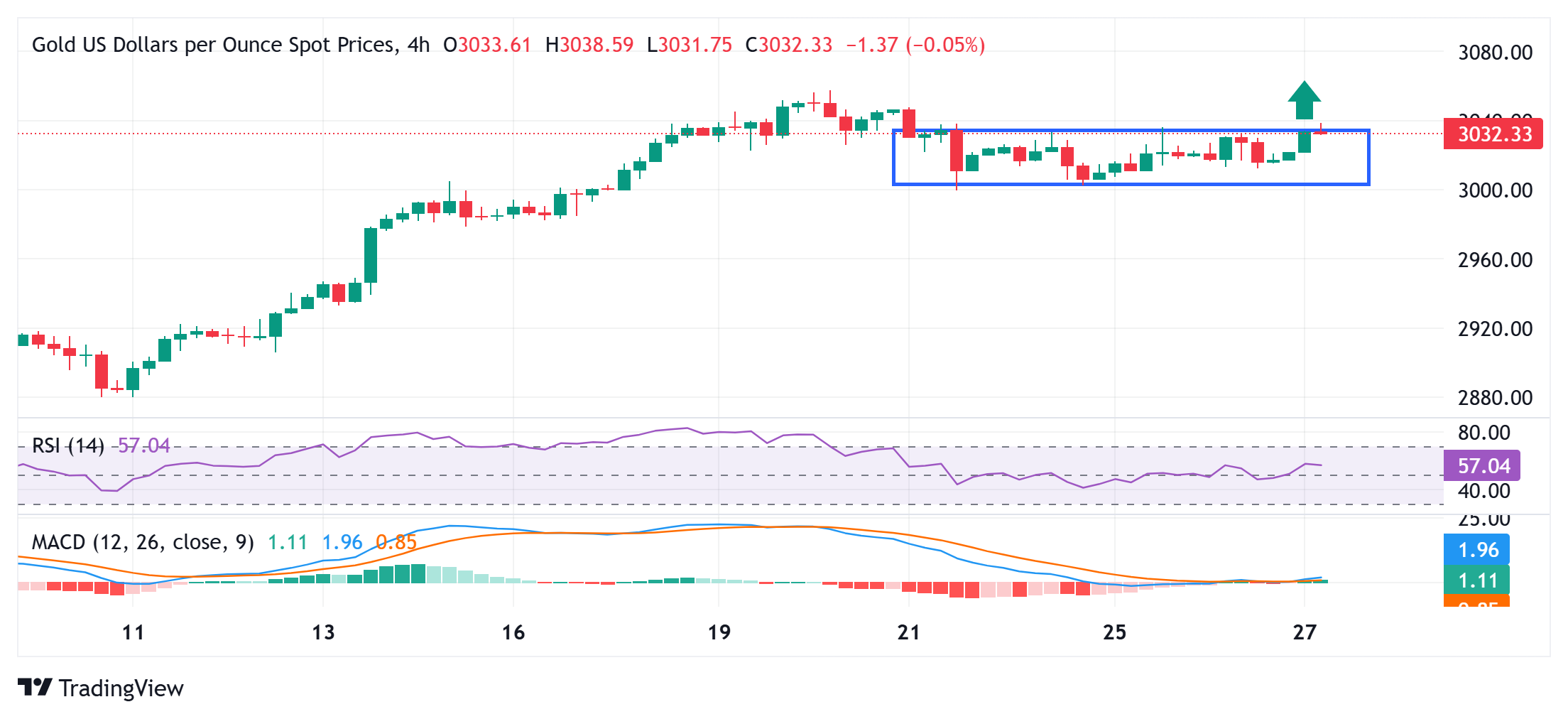Gold price refreshes weekly top; seems poised to appreciate further amid trade jitters
- Gold price regains positive traction on Thursday as rising trade tensions boost safe-haven demand.
- A modest USD pullback from a multi-week top and Fed rate cut bets also back the XAU/USD pair.
- Traders look to Thursday’s US macro releases for some impetus ahead of the US PCE data on Friday.
Gold price (XAU/USD) attracts fresh buyers following the previous day's flat close and climbs to a fresh weekly high, around the $3,038-3,039 region during the Asian session on Thursday. US President Donald Trump unveiled a 25% tariff on imported cars and light trucks starting next week, widening the global trade war. Adding to this, the uncertainty over Trump's so-called reciprocal tariffs tempers investors' appetite for riskier assets and underpins demand for the safe-haven bullion.
Meanwhile, the US Dollar (USD) struggles to capitalize on the overnight gains, fueled by the better-than-expected release of US Durable Goods Orders, and retreats after hitting a three-week top amid dovish Federal Reserve (Fed) expectations. This turns out to be another factor that benefits the non-yielding Gold price. However, the recent rise in the US Treasury bond yields could limit USD losses and hold traders from placing aggressive bullish bets around the XAU/USD pair.
Daily Digest Market Movers: Gold price draws support from a global flight to safety and a modest USD downtick
- The global risk sentiment took a hit in reaction to US President Donald Trump's new auto tariffs announced on Wednesday. Adding to this, the uncertainty over Trump's impending reciprocal tariff next week weighs on investors' sentiment and revives demand for the traditional safe-haven Gold price on Thursday.
- The uncertainty over the impact of Trump's trade policies forced the Federal Reserve to revise its growth outlook downward. Moreover, the US central bank signaled that it would deliver two 25-basis-point interest rate cuts in 2025. This overshadows Wednesday's upbeat US macro data and weighs on the US Dollar.
- In fact, the US Commerce Department reported that Durable Goods Orders rose 0.9% in February, while Core Durable Goods, which strips out the volatile transportation sector, increased by 0.7%. The readings were better than consensus estimates and led to the overnight USD move higher to a three-week high.
- Chicago Fed President Austan Goolsbee told the Financial Times that it may take longer than anticipated for the next cut because of economic uncertainty. If markets start factoring higher inflation then he would view that as a major red flag area of concern for policymaking decisions, Goolsbee added further.
- Adding to this, Minneapolis Fed President Neel Kashkari argued that the central bank has made a lot of progress in bringing inflation down, but will have more work to do to get inflation back to the 2% target. Kashkari also said that he is uncertain about the effect of Trump's aggressive policies on the US economy.
- Separately, St. Louis Fed President Alberto Musalem said that there is no urgency for the US central bank to cut rates given the fact that restrictive policy is still needed to ensure inflation falls to the 2% target. He expects US economic growth to remain still decent, while prices may be pushed higher by tariffs.
- Traders now look forward to Thursday's US economic docket – featuring the release of the final Q4 GDP print, Weekly Initial Jobless Claims, and Pending Home Sales data. This, along with speeches by influential FOMC members, will drive the USD demand and produce short-term opportunities around the commodity.
- The focus, however, will remain glued to the US Personal Consumption Expenditure (PCE) Price Index on Friday, which could provide some cues about the Fed's future interest rate-cut path. This, in turn, will play a key role in determining the next leg of a directional move for the buck and the non-yielding yellow metal.
Gold price could aim to challenge the all-time peak, around the $3,057-3,058 area touched earlier this month

From a technical perspective, the bullish resilience near the $3,000 psychological mark and the subsequent move up favor bulls amid broadly positive oscillators on the daily chart. Hence, some follow-through buying should allow the Gold price to aim back towards challenging the all-time peak, around the $3,057-3,058 region touched on March 20. A sustained strength beyond will set the stage for an extension of the recent well-established uptrend witnessed over the past four months or so.
On the flip side, the $3,020-3,019 horizontal zone might now protect the immediate downside ahead of the $3,000 psychological mark. This is followed by support near the $2,982-2,978 region, below which the Gold price could extend the corrective slide further towards the next relevant support near the $2,956-2,954 region. The latter represents a horizontal resistance breakpoint and should act as a key pivotal point, which if broken might prompt some technical selling and pave the way for deeper losses.
Gold FAQs
Gold has played a key role in human’s history as it has been widely used as a store of value and medium of exchange. Currently, apart from its shine and usage for jewelry, the precious metal is widely seen as a safe-haven asset, meaning that it is considered a good investment during turbulent times. Gold is also widely seen as a hedge against inflation and against depreciating currencies as it doesn’t rely on any specific issuer or government.
Central banks are the biggest Gold holders. In their aim to support their currencies in turbulent times, central banks tend to diversify their reserves and buy Gold to improve the perceived strength of the economy and the currency. High Gold reserves can be a source of trust for a country’s solvency. Central banks added 1,136 tonnes of Gold worth around $70 billion to their reserves in 2022, according to data from the World Gold Council. This is the highest yearly purchase since records began. Central banks from emerging economies such as China, India and Turkey are quickly increasing their Gold reserves.
Gold has an inverse correlation with the US Dollar and US Treasuries, which are both major reserve and safe-haven assets. When the Dollar depreciates, Gold tends to rise, enabling investors and central banks to diversify their assets in turbulent times. Gold is also inversely correlated with risk assets. A rally in the stock market tends to weaken Gold price, while sell-offs in riskier markets tend to favor the precious metal.
The price can move due to a wide range of factors. Geopolitical instability or fears of a deep recession can quickly make Gold price escalate due to its safe-haven status. As a yield-less asset, Gold tends to rise with lower interest rates, while higher cost of money usually weighs down on the yellow metal. Still, most moves depend on how the US Dollar (USD) behaves as the asset is priced in dollars (XAU/USD). A strong Dollar tends to keep the price of Gold controlled, whereas a weaker Dollar is likely to push Gold prices up.

